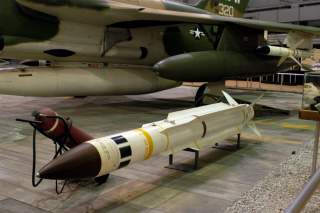A Boss Weapon: It's the AGM-78 Standard Anti-Radiation Missile
Pretty neat.
“[The AGM-78 was a very interesting piece of machinery, and General Dynamics had its technical representatives at Korat to assist the poor stupid crews that had to deal with it.
Here are excerpts from “Reflections of a Weasel” by Major James F. Leggett, who flew 150 Weasel missions in Southeast Asia during 1971-1972, as printed in Red River Valley Fighter Pilots (Nashville, TN: Turner Publishing Company, 1992). You can find them in Dennis R. Jenkins with Mick Roth and Mike Machat book Thunderchief The Complete History of the Republic F-105.
“[The AGM-78 was a very interesting piece of machinery, and General Dynamics had its technical representatives at Korat to assist the poor stupid crews that had to deal with it. It became the fashion, in order to save one’s life, because of the misfiring and the ungodly maneuverability with that 10,000-pound missile [it actually weighed 1,390 pounds] on the right inboard, for some crews to jettison the missile as they crossed over the border into the northern route packs of North Vietnam, if they couldn’t find something to shoot it at before then.
“To avoid this, the answer of the ‘head shed’ at General Dynamics was to wire out the jettison capability from the pylon for the AGM-78. That meant that on takeoff or in any emergency en route, you could not get rid of the AGM-78 without firing it. Neat huh!
“At any rate, I had the technical representative, Bill Barbari, swear to me on a stack of Bibles that the AGM-78 could not ignite on the wing. Being from a long line of machinists and people that work with machinery, I was convinced that anything that could be made by man could malfunction. Sure enough, one night while patrolling the southern route packs and the northern part of South Vietnam above Da Nang, we were on the lookout for a SAM site that had been moved in below “Bat” Lake near the DMZ. As we were patrolling the area, we picked up an intermittent signal that was the right frequency and fit all the parameters for a SAM, although it had some problems with being cyclical.
“Being dutiful and being also a ‘wing puke,’ we transmitted the frequency and PRF of the signal to 7th Air Force before we fired, and got a clearance to fire. Knowing the propensity of the AGM-78 to misfire, I oriented the aircraft north and south and waited until I was past Da Nang before freezing fire button.
“The AGM-78 smartly accepted the target, acknowledged the ‘fire’ signal, had the front of the missile released from the front lug, the pigtail was pulled, and the missile smartly fired on my right wing without releasing the rear lug. Fortunately, this event occurred before they had wired off the jettison capability of the inboard pylons, and I returned to Korat with a clean airplane to receive an autographed photograph of a Sopwith Camel with a rocket on its wing acting much like some of our fireworks ‘buzz-bombs.’ I do not believe that the fellow in the back seat has yet to regain his night vision, as his head was right next to the burning tail of the AGM-78. By the way, the SAM turned out to be a Navy ship up the DMZriver and the Navy ‘forgot’ to tell 7th Air Force or give it the radar parameters.”
This article by Dario Leone originally appeared on The Aviation Geek Club in 2019.
Image: Wikimedia

